Munson B.R. Fundamentals of Fluid Mechanics
Подождите немного. Документ загружается.

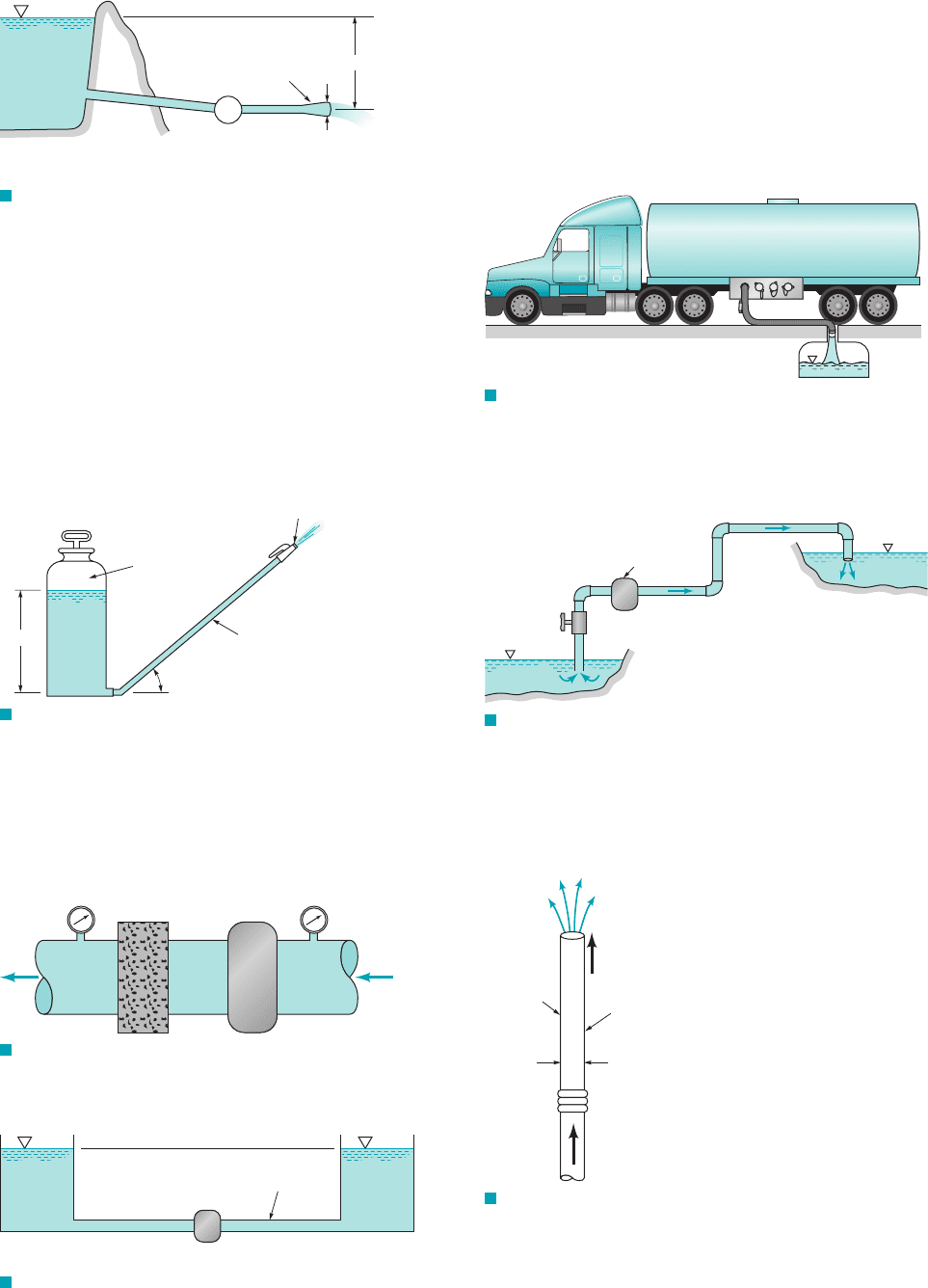
*8.92 In some locations with very “hard” water, a scale can build
up on the walls of pipes to such an extent that not only does the
roughness increases with time, but the diameter significantly de-
creases with time. Consider a case for which the roughness and di-
ameter vary as mm, D 50 (1 0.02t) mm,
where t is in years. Plot the flowrate as a function of time for t 0
to t 10 years if the pressure drop per 12 m of horizontal pipe re-
mains constant at .
8.93 Water flows from the nozzle attached to the spray tank shown
in Fig. P8.93. Determine the flowrate if the loss coefficient for the
nozzle (based on upstream conditions) is 0.75 and the friction fac-
tor for the rough hose is 0.11.
¢p ⫽ 1.3 kPa
⫽
⫽
⫺⫽e ⫽ 0.02 ⫹ 0.01t
the flowrate passing between the tanks? Assume the friction fac-
tor to be equal to 0.02 and minor losses to be negligible.
8.96 Gasoline is unloaded from the tanker truck shown in
Fig. P8.96 through a 4-in.-diameter rough-surfaced hose. This is a
“gravity dump” with no pump to enhance the flowrate. It is claimed
that the 8800-gallon capacity truck can be unloaded in 28 minutes.
Do you agree with this claim? Support your answer with appropri-
ate calculations.
†
8.97 The pump shown in Fig. P8.97 delivers a head of 250 ft to
the water. Determine the power that the pump adds to the water.
The difference in elevation of the two ponds is 200 ft.
8.98 Water flows through two sections of the vertical pipe shown
in Fig. P8.98. The bellows connection cannot support any force in
the vertical direction. The 0.4-ft-diameter pipe weighs 0.2 lb兾ft, and
the friction factor is assumed to be 0.02. At what velocity will the
force, F, required to hold the pipe be zero?
8.99 Water is circulated from a large tank, through a filter, and back
to the tank as shown in Fig. P8.99. The power added to the water by
the pump is Determine the flowrate through the filter.200 ft
#
lb
Ⲑ
s.
8.94 When the pump shown in Fig. P8.94 adds 0.2 horsepower to
the flowing water, the pressures indicated by the two gages are
equal. Determine the flowrate.
Length of pipe between gages ⫽ 60 ft
Pipe diameter ⫽ 0.1 ft
Pipe friction factor ⫽ 0.03
Filter loss coefficient ⫽ 12
8.95 Water is pumped between two large open tanks as shown in
Fig. P8.95. If the pump adds 50 kW of power to the fluid, what is
Problems
457
F I G U R E P8.91
F I G U R E P8.96
F I G U R E P8.97
F I G U R E P8.98
F I G U R E P8.93
F I G U R E P8.94
F I G U R E P8.95
120 m of 0.30-m-diameter
cast-iron pipe
1 m
20 m
Diffuser
T
Nozzle diameter
= 7.5 mm
0.80 m
p = 150 kPa
D = 15 mm
ᐉ = 1.9 m
40
°
PumpFilter
Diameter
D
m
= 0.5 m
Pipe length = 600 m
Pump
Water
Midstate Gasoline
K
L
valve
= 5.0
K
L
elbow
= 1.5
Pipe length = 500 ft
Pipe diameter = 0.75 ft
Pipe roughness = 0
K
L
ent
= 0.8
K
L
exit
= 1.0
Pump
F
V
Free jet
f
= 0.020
Pipe weighs
0.20 lb/ft
Bellows
D = 0.40 ft
JWCL068_ch08_383-460.qxd 9/23/08 11:02 AM Page 457
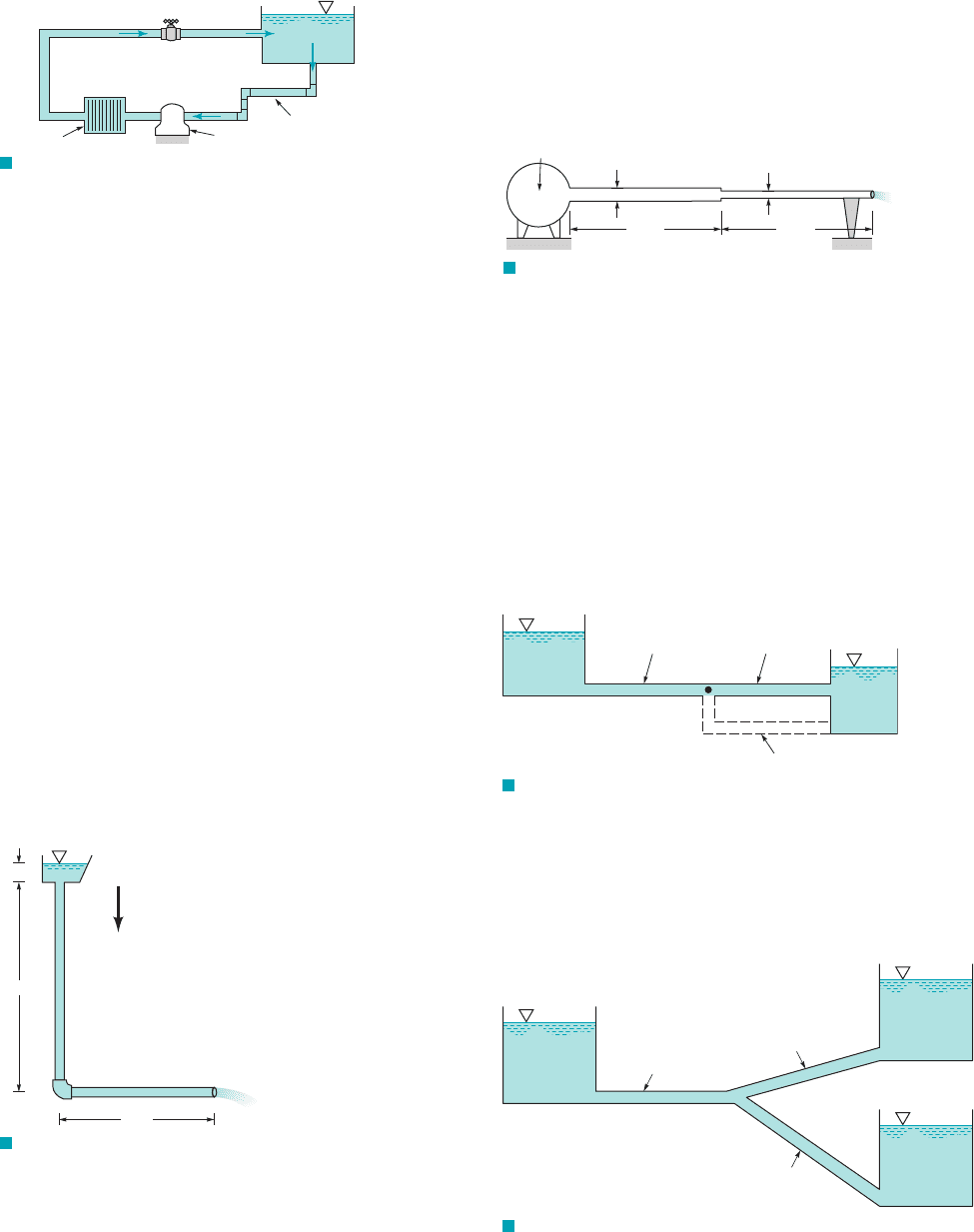
Section 8.5.1 Single Pipes—Determine Diameter
8.100 A certain process requires 2.3 cfs of water to be delivered
at a pressure of 30 psi. This water comes from a large-diameter
supply main in which the pressure remains at 60 psi. If the galva-
nized iron pipe connecting the two locations is 200 ft long and con-
tains six threaded elbows, determine the pipe diameter. Eleva-
tion differences are negligible.
8.101 Water is pumped between two large open reservoirs through
1.5 km of smooth pipe. The water surfaces in the two reservoirs are
at the same elevation. When the pump adds 20 kW to the water the
flowrate is . If minor losses are negligible, determine the pipe
diameter.
8.102 Determine the diameter of a steel pipe that is to carry
of gasoline with a pressure drop of 5 psi per 100 ft of
horizontal pipe.
8.103 Water is to be moved from a large, closed tank in which the
air pressure is 20 psi into a large, open tank through 2000 ft of
smooth pipe at the rate of The fluid level in the open tank
is 150 ft below that in the closed tank. Determine the required di-
ameter of the pipe. Neglect minor losses.
8.104 Rainwater flows through the galvanized iron downspout
shown in Fig. P8.104 at a rate of Determine the size
of the downspout cross section if it is a rectangle with an aspect
ratio of 1.7 to 1 and it is completely filled with water. Neglect the
velocity of the water in the gutter at the free surface and the head
loss associated with the elbow.
0.006 m
3
Ⲑ
s.
3 ft
3
Ⲑ
s.
2000 gal
Ⲑ
min
1 m
3
Ⲑ
s
90°
458 Chapter 8 ■ Viscous Flow in Pipes
Pump
Filter
K
L
elbow
= 1.5
K
L
exit
= 1.0
K
L
ent
= 0.8
K
L
valve
= 6.0
K
L
filter
= 12.0
200 ft. of 0.1-ft-diameter
pipe with ε/
D = 0.01
F I G U R E P8.99
g
70 mm
4 m
3 m
F I G U R E P8.104
*8.105 Repeat Problem 8.104 if the downspout is circular.
Section 8.5.2 Multiple Pipe Systems
8.106 Obtain a photograph/image of a multiple pipe system with
series of parallel flows. Print this photo and write a brief paragraph
that describes the situation involved.
8.107 Air, assumed incompressible, flows through the two pipes
shown in Fig. P8.107. Determine the flowrate if minor losses are
neglected and the friction factor in each pipe is 0.015. Determine
the flowrate if the 0.5-in.-diameter pipe were replaced by a 1-in.-
diameter pipe. Comment on the assumption of incompressibility.
*8.108 Repeat Problem 8.107 if the pipes are galvanized iron and
the friction factors are not known a priori.
†8.109 Estimate the power that the human heart must impart to
the blood to pump it through the two carotid arteries from the heart
to the brain. List all assumptions and show all calculations.
8.110 The flowrate between tank A and tank B shown in
Fig. P8.110 is to be increased by 30% (i.e., from Q to 1.30Q) by
the addition of a second pipe (indicated by the dotted lines) run-
ning from node C to tank B. If the elevation of the free surface in
tank A is 25 ft above that in tank B, determine the diameter, D, of
this new pipe. Neglect minor losses and assume that the friction
factor for each pipe is 0.02.
p
= 0.5 psi
T = 150°F
20 ft 20 ft
1 in.
0.50 in.
F I G U R E P8.107
F I G U R E P8.110
6-in. diameter;
600 ft long
6-in. diameter;
500 ft long
C
Diameter D, 500 ft long
A
B
F I G U R E P8.111
Elevation =
838 ft
Elevation =
850 ft
Elevation =
805 ft
D = 1.0 ft
ᐉ = 800 ft
D = 1.1 ft
ᐉ = 700 ft
D = 1.2 ft
ᐉ = 600 ft
A
B
C
8.111 The three tanks shown in Fig. P8.111 are connected by pipes
with friction factors of 0.03 for each pipe. Determine the water ve-
locity in each pipe. Neglect minor losses.
8.112 The three water-filled tanks shown in Fig. P8.112 are con-
nected by pipes as indicated. If minor losses are neglected, deter-
mine the flowrate in each pipe.
JWCL068_ch08_383-460.qxd 9/23/08 11:02 AM Page 458
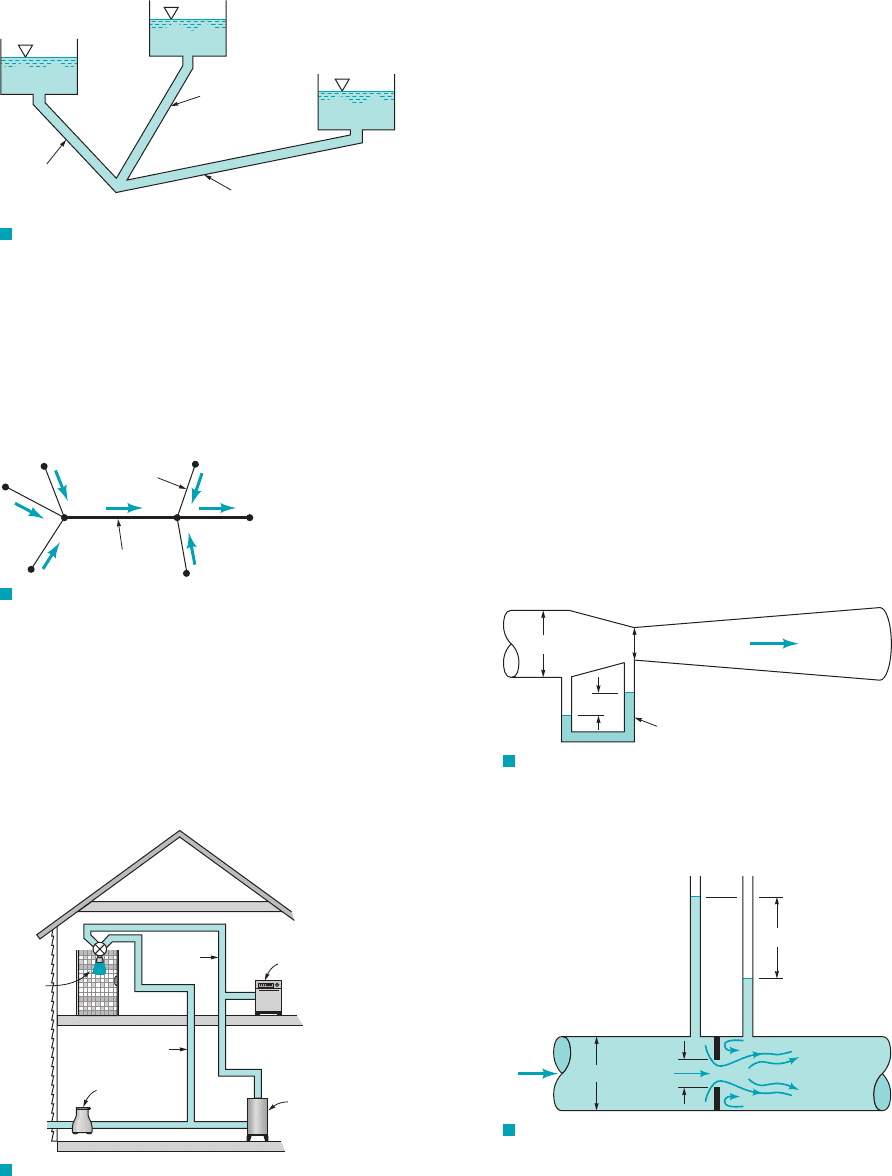
8.113 (See Fluids in the News article titled “Deepwater pipeline,”
Section 8.5.2.) Five oil fields, each producing an output of Q bar-
rels per day, are connected to the 28-in.-diameter “main line pipe”
(A–B–C) by 16-in.-diameter “lateral pipes” as shown in Fig.
P8.113. The friction factor is the same for each of the pipes and
elevation effects are negligible. (a) For section A–B determine the
ratio of the pressure drop per mile in the main line pipe to that in
the lateral pipes. (b) Repeat the calculations for section B–C.
Problems
459
Elevation = 20 m
Elevation = 60 m
Elevation = 0
= 0.10 m
= 200 m
= 0.015
D
ᐉ
f
= 0.08 m
= 400 m
= 0.020
D
ᐉ
f
= 0.08 m
= 200 m
= 0.020
D
ᐉ
f
F I G U R E P8.112
F I G U R E P8.113
Lateral
Main line
Q
Q
Q
Q
Q
A BC
F I G U R E P8.114
Water meter
Shower
Hot water heater
Dishwasher
Hot
Cold
†8.114 As shown in Fig. P8.114, cold water (T 50 F) flows
from the water meter to either the shower or the hot water heater.
In the hot water heater it is heated to a temperature of 150 F. Thus,
with equal amounts of hot and cold water, the shower is at a com-
fortable 100 F. However, when the dishwasher is turned on, the
shower water becomes too cold. Indicate how you would predict
this new shower temperature (assume the shower faucet is not ad-
justed). State any assumptions needed in your analysis.
Section 8.6 Pipe Flowrate Measurement (Also see Lab
Problem 8.127.)
8.115 Obtain a photograph/image of a flowrate measurement de-
vice. Print this photo and write a brief paragraph that describes the
measurement range of the device.
8.116 A 2-in.-diameter orifice plate is inserted in a 3-in.-diameter
pipe. If the water flowrate through the pipe is 0.90 cfs, determine
the pressure difference indicated by a manometer attached to the
flow meter.
8.117 Air to ventilate an underground mine flows through a large
2-m-diameter pipe. A crude flowrate meter is constructed by placing
a sheet metal “washer” between two sections of the pipe. Estimate
the flowrate if the hole in the sheet metal has a diameter of 1.6 m and
the pressure difference across the sheet metal is 8.0 mm of water.
8.118 Water flows through a 40-mm-diameter nozzle meter in a
75-mm-diameter pipe at a rate of Determine the pres-
sure difference across the nozzle if the temperature is (a)
or (b)
8.119 Air at and 60 psia flows in a 4-in.-diameter pipe at
a rate of 0.52 lb s. Determine the pressure at the 2-in.-diameter
throat of a Venturi meter placed in the pipe.
8.120 A 2.5-in.-diameter flow nozzle is installed in a 3.8-in.-
diameter pipe that carries water at If the air–water
manometer used to measure the pressure difference across the me-
ter indicates a reading of 3.1 ft, determine the flowrate.
8.121 A 0.064-m-diameter nozzle meter is installed in a 0.097 m-
diameter pipe that carries water at If the inverted air–water
U-tube manometer used to measure the pressure difference across
the meter indicates a reading of 1 m, determine the flowrate.
8.122 Water flows through the Venturi meter shown in
Fig. P8.122. The specific gravity of the manometer fluid is 1.52.
Determine the flowrate.
60 °C.
160 °F.
200 °F
80 °C.
10 °C,
0.015 m
3
s.
h
Q
d
2 in.
F I G U R E P8.123
3 in.6 in.
2 in.
SG = 1.52
Q
F I G U R E P8.122
8.123 Water flows through the orifice meter shown in Fig. P8.123
at a rate of 0.10 cfs. If ft, determine the value of h.d 0.1
8.124 Water flows through the orifice meter shown in Fig. P8.123
such that ft with in. Determine the flowrate.
8.125 The scale reading on the rotameter shown in Fig. P8.125
and Video V8.14 (also see Fig. 8.46) is directly proportional to the
volumetric flowrate. With a scale reading of 2.6 the water bubbles
up approximately 3 in. How far will it bubble up if the scale read-
ing is 5.0?
d 1.5h 1.6
JWCL068_ch08_383-460.qxd 9/30/08 8:41 AM Page 459
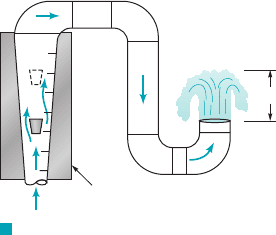
■ Lab Problems
8.126 This problem involves the determination of the friction fac-
tor in a pipe for laminar and transitional flow conditions. To pro-
ceed with this problem, go to Appendix H which is located on the
book’s web site, www.wiley.com/college/munson.
8.127 This problem involves the calibration of an orifice meter
and a Venturi meter. To proceed with this problem, go to Appen-
dix H which is located on the book’s web site, www.wiley.com/
college/munson.
8.128 This problem involves the flow of water from a tank and
through a pipe system. To proceed with this problem, go to
Appendix H which is located on the book’s web site, www.wiley.
com/college/munson.
8.129 This problem involves the flow of water pumped from a tank
and through a pipe system. To proceed with this problem, go to
Appendix H which is located on the book’s web site, www.wiley.
com/college/munson.
8.130 This problem involves the pressure distribution in the en-
trance region of a pipe. To proceed with this problem, go to
Appendix H which is located on the book’s web site, www.wiley.
com/college/munson.
8.131 This problem involves the power loss due to friction in a
coiled pipe. To proceed with this problem, go to Appendix H which
is located on the book’s web site, www.wiley.com/college/munson.
■ Life Long Learning Problems
8.132 The field of bioengineering has undergone significant
growth in recent years. Some universities have undergraduate and
graduate programs in this field. Bioengineering applies engineer-
ing principles to help solve problems in the medical field for hu-
man health. Obtain information about bioengineering applications
in blood flow. Summarize your findings in a brief report.
8.133 Data used in the Moody diagram were first published in
1944. Since then, there have been many innovations in pipe mate-
rial, pipe design, and measurement techniques. Investigate whether
there have been any improvements or enhancements to the Moody
chart. Summarize your findings in a brief report.
460 Chapter 8 ■ Viscous Flow in Pipes
8.134 As discussed in Sec. 8.4.2, flow separation in pipes can lead
to losses (we will also see in Chapter 9 that external flow separation
is a significant problem). For external flows, there have been many
mechanisms devised to help mitigate and control flow separation
from the surface, e.g., from the wing of an airplane. Investigate ei-
ther passive or active flow control mechanisms that can reduce or
eliminate internal flow separation (e.g., flow separation in a diffuser).
Summarize your findings in a brief report.
■ FlowLab Problems
*8.135 This FlowLab problem involves simulating the flow in the
entrance region of a pipe and looking at basic concepts involved
with the flow regime. To proceed with this problem, go to the
book’s web site, www.wiley.com/college/munson.
*8.136 This FlowLab problem involves investigation of the cen-
terline pressure distribution along a pipe. To proceed with this prob-
lem, go to the book’s web site, www.wiley.com/college/munson.
*8.137 This FlowLab problem involves conducting a parametric
study to see how Reynolds number affects the entrance length of
a pipe. To proceed with this problem, go to the book’s web site,
www.wiley.com/college/munson.
*8.138 This FlowLab problem involves investigation of pressure
drop in the entrance region of a pipe as a function of Reynolds
number as well as comparing simulation results to analytic values.
To proceed with this problem, go to the book’s web site, www.
wiley.com/college/munson.
*8.139 This FlowLab problem involves the simulation of fully de-
veloped pipe flow and how the Reynolds number affects the wall
friction. To proceed with this problem, go to the book’s web site,
www.wiley.com/college/munson.
*8.140 This FlowLab problem involves conducting a parametric
study on the effects of a sudden pipe expansion on the overall pres-
sure drop in a pipe. To proceed with this problem, go to the book’s
web site, www.wiley.com/college/munson.
*8.141 This FlowLab problem involves investigation of effects of
the pipe expansion ratio on flow separation. To proceed with this
problem, go to the book’s web site, www.wiley.com/college/munson.
*8.142 This FlowLab problem involves investigation of geometric
effects of a diffuser on the resulting flow field. To proceed with this
problem, go to the book’s web site, www.wiley.com/college/munson.
*8.143 This FlowLab problem involves investigating the effects
of the diameter ratio for a flat plate type orifice meter. To proceed
with this problem, go to the book’s web site, www.wiley.com/
college/munson.
■ FE Exam Problems
Sample FE (Fundamentals of Engineering) exam questions for
fluid mechanics are provided on the book’s web site, www.wiley.
com/college/munson.
Rotameter
3 in.
0
6
5
4
3
2
1
F I G U R E P8.125
JWCL068_ch08_383-460.qxd 9/23/08 11:02 AM Page 460
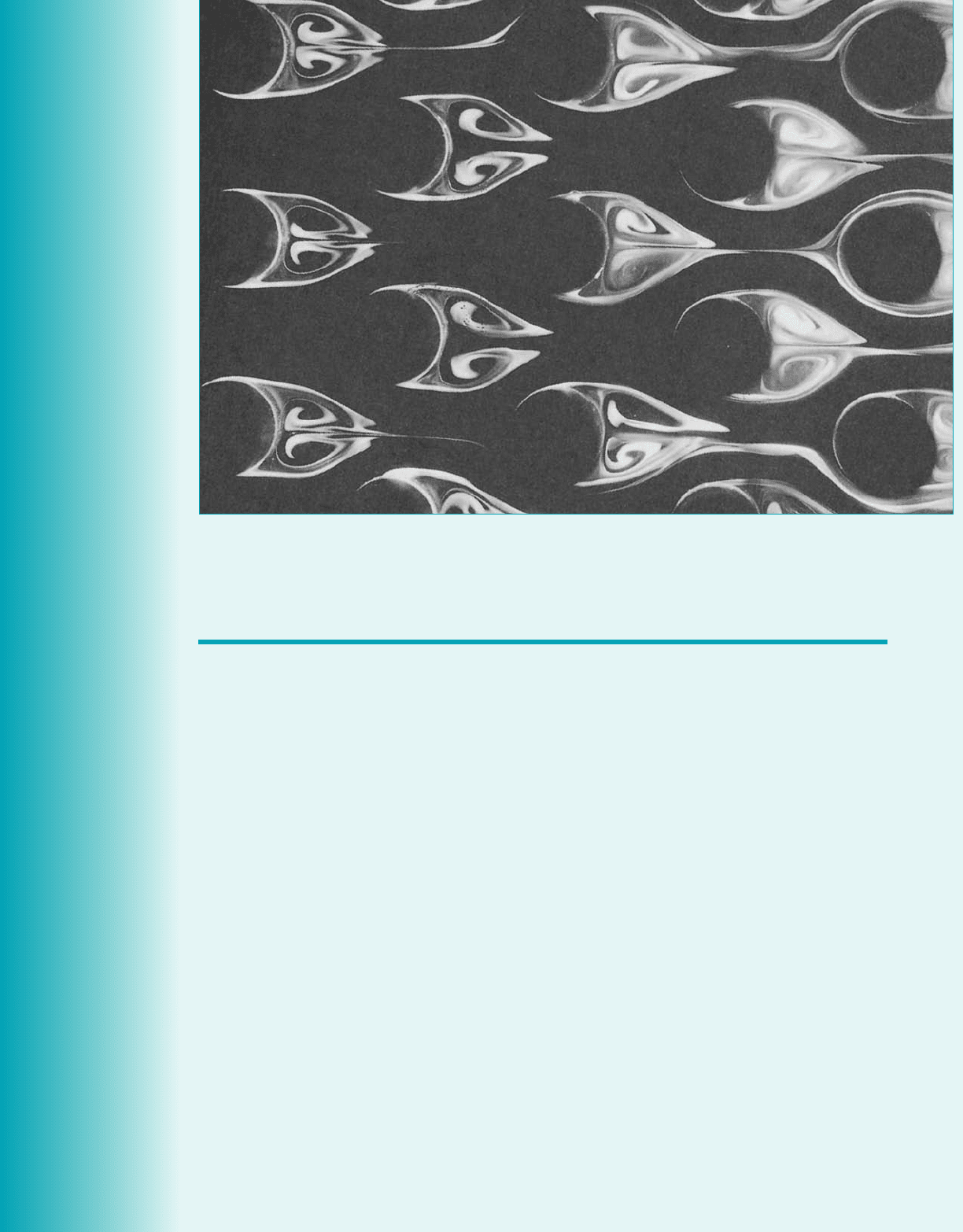
461
CHAPTER OPENING PHOTO: Impulsive start of flow past an array of cylinders: The complex structure of lam-
inar flow past a relatively simple geometric structure illustrates why it is often difficult to obtain exact ana-
lytical results for external flows. 1Dye in water.2(Photograph courtesy of ONERA, France.)
Learning Objectives
After completing this chapter, you should be able to:
■ identify and discuss the features of external flow.
■ explain the fundamental characteristics of a boundary layer, including laminar,
transitional, and turbulent regimes.
■ calculate boundary layer paremeters for flow past a flat plate.
■ provide a description of boundary layer separation.
■ calculate the lift and drag forces for various objects.
In this chapter we consider various aspects of the flow over bodies that are immersed in a fluid.
Examples include the flow of air around airplanes, automobiles, and falling snowflakes, or the flow
of water around submarines and fish. In these situations the object is completely surrounded by
the fluid and the flows are termed external flows.
External flows involving air are often termed aerodynamics in response to the important exter-
nal flows produced when an object such as an airplane flies through the atmosphere. Although this
field of external flows is extremely important, there are many other examples that are of equal impor-
tance. The fluid force 1lift and drag2on surface vehicles 1cars, trucks, bicycles2has become a very
important topic. By correctly designing cars and trucks, it has become possible to greatly decrease the
fuel consumption and improve the handling characteristics of the vehicle. Similar efforts have resulted
in improved ships, whether they are surface vessels 1surrounded by two fluids, air and water2or sub-
mersible vessels 1surrounded completely by water2.
Other applications of external flows involve objects that are not completely surrounded by
fluid, although they are placed in some external-type flow. For example, the proper design of a
9
9
F
low over
Immersed Bodies
F
low over
Immersed Bodies
Many practical sit-
uations involve
flow past objects.
JWCL068_ch09_461-533.qxd 9/23/08 11:47 AM Page 461
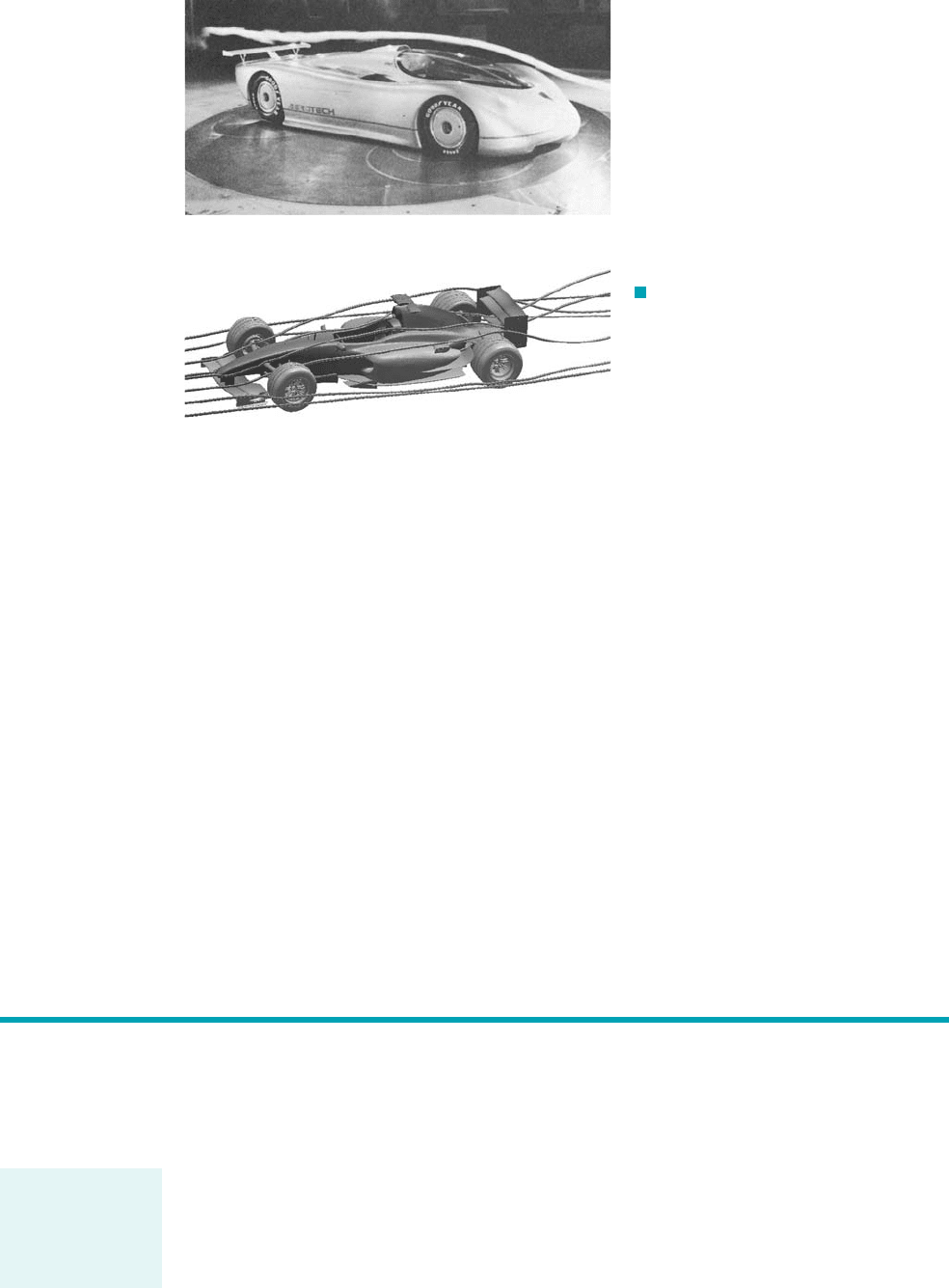
building 1whether it is your house or a tall skyscraper2must include consideration of the various
wind effects involved.
As with other areas of fluid mechanics, various approaches 1theoretical, numerical and ex-
perimental2are used to obtain information on the fluid forces developed by external flows.
Theoretical 1i.e., analytical2techniques can provide some of the needed information about such
flows. However, because of the complexities of the governing equations and the complexities of
the geometry of the objects involved, the amount of information obtained from purely theoreti-
cal methods is limited.
Much of the information about external flows comes from experiments carried out, for the
most part, on scale models of the actual objects. Such testing includes the obvious wind tunnel
testing of model airplanes, buildings, and even entire cities. In some instances the actual device,
not a model, is tested in wind tunnels. Figure 9.1a shows a test of a vehicle in a wind tunnel. Bet-
ter performance of cars, bikes, skiers, and numerous other objects has resulted from testing in wind
tunnels. The use of water tunnels and towing tanks also provides useful information about the flow
around ships and other objects. With advancement in computational fluid dynamics, or CFD, nu-
merical methods are also capable of predicting external flows past objects. Figure 9.1b shows stream-
lines around a Formula 1 car as predicted by CFD. Appendix A provides an introduction to CFD.
In this chapter we consider characteristics of external flow past a variety of objects. We in-
vestigate the qualitative aspects of such flows and learn how to determine the various forces on
objects surrounded by a moving liquid.
462 Chapter 9 ■ Flow over Immersed Bodies
A body immersed in a moving fluid experiences a resultant force due to the interaction between
the body and the fluid surrounding it. In some instances 1such as an airplane flying through still
air2the fluid far from the body is stationary and the body moves through the fluid with veloc-
ity U. In other instances 1such as the wind blowing past a building2the body is stationary and
the fluid flows past the body with velocity U. In any case, we can fix the coordinate system in
the body and treat the situation as fluid flowing past a stationary body with velocity U, the up-
stream velocity. For the purposes of this book, we will assume that the upstream velocity is con-
stant in both time and location. That is, there is a uniform, constant velocity fluid flowing past the
object. In actual situations this is often not true. For example, the wind blowing past a smokestack
is nearly always turbulent and gusty 1unsteady2and probably not of uniform velocity from the top
to the bottom of the stack. Usually the unsteadiness and nonuniformity are of minor importance.
9.1 General External Flow Characteristics
F I G U R E 9.1 (a) Flow past a
full-sized streamlined vehicle in the GM
aerodynamics laboratory wind tunnel, an 18-ft
by 34-ft test section facility driven by a 4000-
hp, 43-ft-diameter fan. (Photograph courtesy
of General Motors Corporation.) (b) Predicted
streamlines for flow past a Formula 1 race
car as obtained by using computational fluid
dynamics techniques. (Courtesy of Ansys, Inc.)
(a)
(
b)
For external flows
it is usually easiest
to use a coordinate
system fixed to the
object.
JWCL068_ch09_461-533.qxd 9/23/08 11:47 AM Page 462
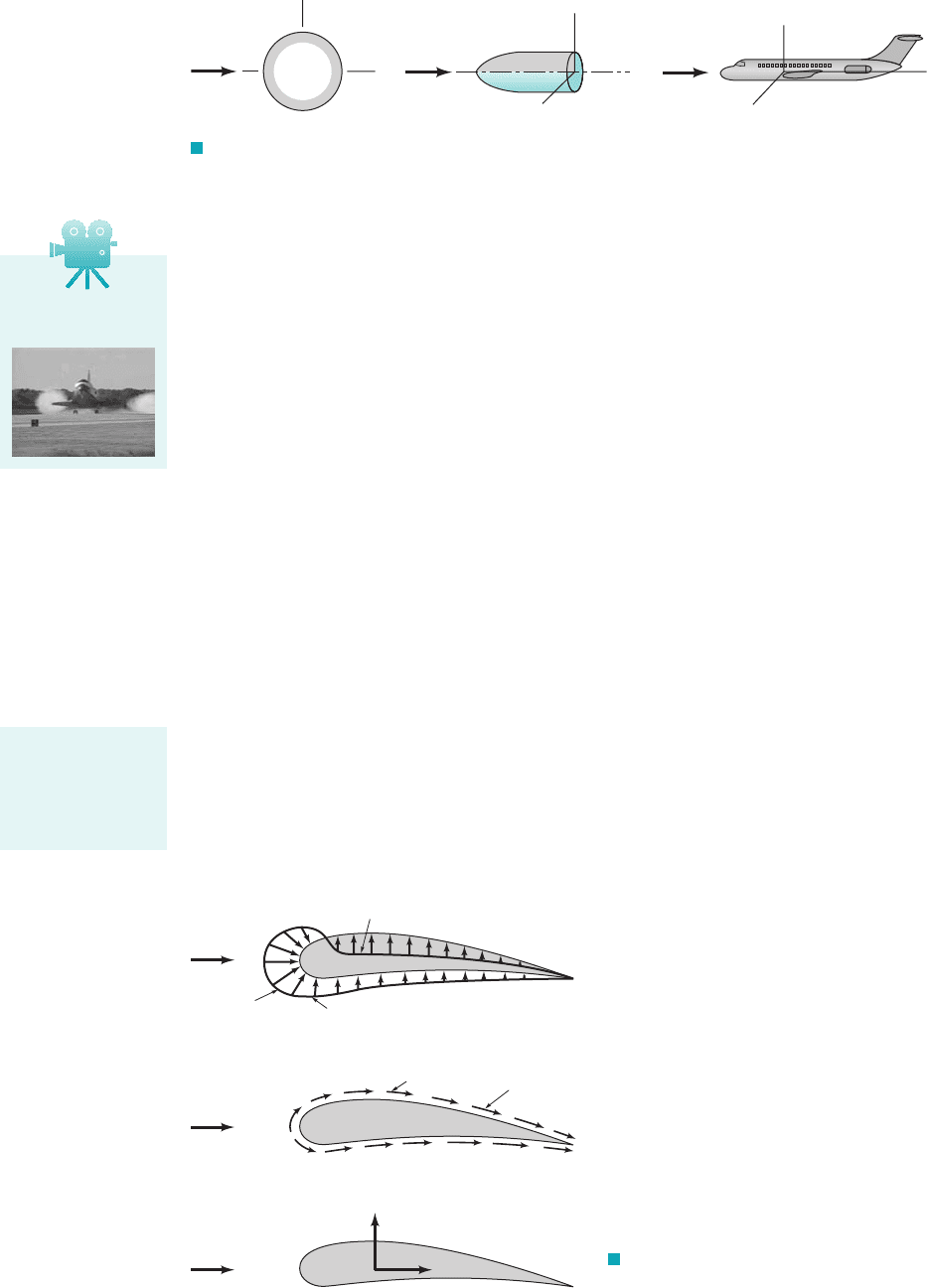
Even with a steady, uniform upstream flow, the flow in the vicinity of an object may be un-
steady. Examples of this type of behavior include the flutter that is sometimes found in the flow
past airfoils 1wings2, the regular oscillation of telephone wires that “sing” in a wind, and the irreg-
ular turbulent fluctuations in the wake regions behind bodies.
The structure of an external flow and the ease with which the flow can be described and an-
alyzed often depend on the nature of the body in the flow. Three general categories of bodies are
shown in Fig. 9.2. They include 1a2two-dimensional objects 1infinitely long and of constant cross-
sectional size and shape2, 1b2axisymmetric bodies 1formed by rotating their cross-sectional shape
about the axis of symmetry2, and 1c2three-dimensional bodies that may or may not possess a line
or plane of symmetry. In practice there can be no truly two-dimensional bodies—nothing extends
to infinity. However, many objects are sufficiently long so that the end effects are negligibly small.
Another classification of body shape can be made depending on whether the body is stream-
lined or blunt. The flow characteristics depend strongly on the amount of streamlining present. In
general, streamlined bodies 1i.e., airfoils, racing cars, etc.2have little effect on the surrounding fluid,
compared with the effect that blunt bodies 1i.e., parachutes, buildings, etc.2have on the fluid. Usu-
ally, but not always, it is easier to force a streamlined body through a fluid than it is to force a
similar-sized blunt body at the same velocity. There are important exceptions to this basic rule.
9.1.1 Lift and Drag Concepts
When any body moves through a fluid, an interaction between the body and the fluid occurs; this
effect can be given in terms of the forces at the fluid–body interface. These forces can be described
in terms of the stresses—wall shear stresses, due to viscous effects and normal stresses due to
the pressure, p. Typical shear stress and pressure distributions are shown in Figs. 9.3a and 9.3b.
Both and p vary in magnitude and direction along the surface.
It is often useful to know the detailed distribution of shear stress and pressure over the sur-
face of the body, although such information is difficult to obtain. Many times, however, only the
t
w
t
w
,
9.1 General External Flow Characteristics 463
U
U
U
x
z
y
z
y
x
x
y
(c)
(
b)
(
a)
F I G U R E 9.2 Flow classification: (a) two-dimensional, (b) axisymmetric,
(c) three-dimensional.
V9.1 Space shuttle
landing
F I G U R E 9.3 Forces from the sur-
rounding fluid on a two-dimensional object: (a)
pressure force, (b) viscous force, (c) resultant force
(lift and drag).
U
U
U
Ᏸ
ᏸ
(c)
(
b)
(
a)
w
Shear stress
distribution
τ
p > 0
Pressure
distribution
p < 0
A body interacts
with the surround-
ing fluid through
pressure and shear
stresses.
JWCL068_ch09_461-533.qxd 9/23/08 11:47 AM Page 463

integrated or resultant effects of these distributions are needed. The resultant force in the direction
of the upstream velocity is termed the drag, and the resultant force normal to the upstream ve-
locity is termed the lift, as is indicated in Fig. 9.3c. For some three-dimensional bodies there
may also be a side force that is perpendicular to the plane containing and
The resultant of the shear stress and pressure distributions can be obtained by integrating the
effect of these two quantities on the body surface as is indicated in Fig. 9.4. The x and y compo-
nents of the fluid force on the small area element dA are
and
Thus, the net x and y components of the force on the object are
(9.1)
and
(9.2)
Of course, to carry out the integrations and determine the lift and drag, we must know the body
shape 1i.e., as a function of location along the body2and the distribution of and p along the
surface. These distributions are often extremely difficult to obtain, either experimentally or theo-
retically. The pressure distribution can be obtained experimentally by use of a series of static pres-
sure taps along the body surface. On the other hand, it is usually quite difficult to measure the wall
shear stress distribution.
t
w
u
l ⫽
冮
dF
y
⫽⫺
冮
p sin u dA ⫹
冮
t
w
cos u dA
d ⫽
冮
dF
x
⫽
冮
p cos u dA ⫹
冮
t
w
sin u dA
dF
y
⫽⫺1p dA2 sin u ⫹ 1t
w
dA2 cos u
dF
x
⫽ 1p dA2 cos u ⫹ 1t
w
dA2 sin u
l.d
l,
d,
464 Chapter 9 ■ Flow over Immersed Bodies
F I G U R E 9.4 Pressure and shear
forces on a small element of the surface of a
body.
U
pdA
θ
dA
τ
w
dA
θ
y
x
Lift and drag on a
section of a body
depend on the ori-
entation of the sur-
face.
Fluids in the News
Pressure-sensitive paint For many years, the conventional
method for measuring surface pressure has been to use static
pressure taps consisting of small holes on the surface connected
by hoses from the holes to a pressure measuring device. Pressure-
sensitive paint (PSP) is now gaining acceptance as an alternative
to the static surface pressure ports. The PSP material is typically
a luminescent compound that is sensitive to the pressure on it and
can be excited by an appropriate light which is captured by spe-
cial video imaging equipment. Thus, it provides a quantitative
measure of the surface pressure. One of the biggest advantages of
PSP is that it is a global measurement technique, measuring pres-
sure over the entire surface, as opposed to discrete points. PSP
also has the advantage of being nonintrusive to the flow field. Al-
though static pressure port holes are small, they do alter the sur-
face and can slightly alter the flow, thus affecting downstream
ports. In addition, the use of PSP eliminates the need for a large
number of pressure taps and connecting tubes. This allows pres-
sure measurements to be made in less time and at a lower cost.
It is seen that both the shear stress and pressure force contribute to the lift and drag, since
for an arbitrary body is neither zero nor along the entire body. The exception is a flat plate
aligned either parallel to the upstream flow or normal to the upstream flow as
is discussed in Example 9.1.
1u ⫽ 021u ⫽ 90°2
90°u
JWCL068_ch09_461-533.qxd 9/23/08 11:47 AM Page 464
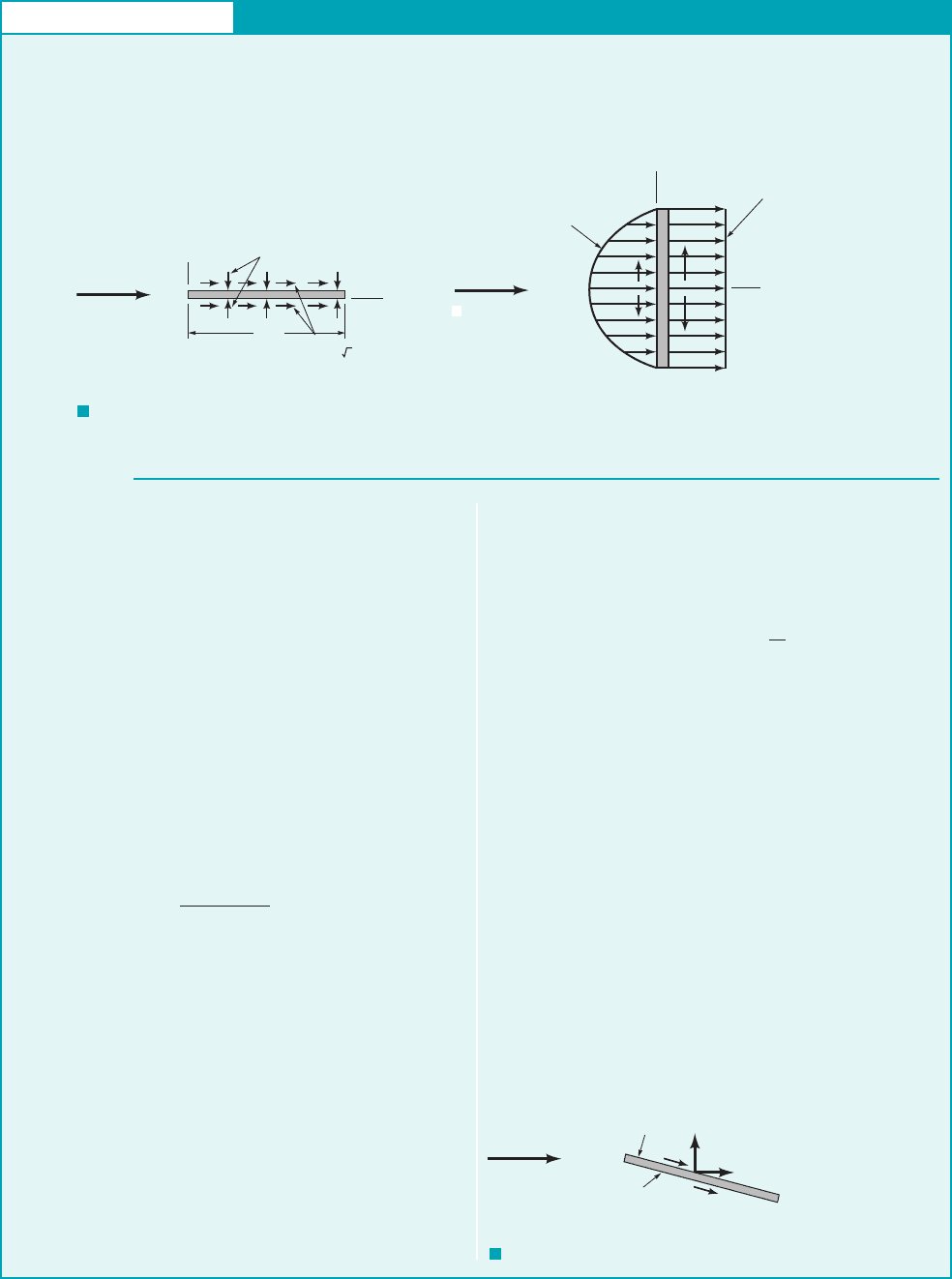
9.1 General External Flow Characteristics 465
GIVEN Air at standard conditions flows past a flat plate as
is indicated in Fig. E9.1. In case 1a2the plate is parallel to the
upstream flow, and in case 1b2it is perpendicular to the up-
stream flow. The pressure and shear stress distributions on
the surface are as indicated 1obtained either by experiment or
theory2.
FIND Determine the lift and drag on the plate.
S
OLUTION
Drag from Pressure and Shear Stress Distributions
symmetrical about the center of the plate. With the given rela-
tively large pressure on the front of the plate 1the center of the
plate is a stagnation point2and the negative pressure 1less than
the upstream pressure2on the back of the plate, we obtain the
following drag
or
(Ans)
COMMENTS Clearly there are two mechanisms responsible
for the drag. On the ultimately streamlined body 1a zero thickness
flat plate parallel to the flow2the drag is entirely due to the shear
stress at the surface and, in this example, is relatively small. For
the ultimately blunted body 1a flat plate normal to the upstream
flow2the drag is entirely due to the pressure difference between
the front and back portions of the object and, in this example, is
relatively large.
If the flat plate were oriented at an arbitrary angle relative to
the upstream flow as indicated in Fig. E9.1c, there would be both
a lift and a drag, each of which would be dependent on both the
shear stress and the pressure. Both the pressure and shear stress
distributions would be different for the top and bottom surfaces.
d ⫽ 55.6 lb
⫺ 1⫺0.8932 lb
Ⲑ
ft
2
d 110 ft2 dy
d ⫽
冮
2 ft
y⫽⫺2
c0.744 a1 ⫺
y
2
4
b lb
Ⲑ
ft
2
E
XAMPLE 9.1
For either orientation of the plate, the lift and drag are obtained
from Eqs. 9.1 and 9.2. With the plate parallel to the upstream flow
we have on the top surface and on the bottom
surface so that the lift and drag are given by
and
(1)
where we have used the fact that because of symmetry the shear
stress distribution is the same on the top and the bottom surfaces,
as is the pressure also [whether we use gage or absolute
pressure]. There is no lift generated—the plate does
not know up from down. With the given shear stress distribution,
Eq. 1 gives
or
(Ans)
With the plate perpendicular to the upstream flow, we have
on the front and on the back. Thus, from Eqs.
9.1 and 9.2
and
Again there is no lift because the pressure forces act parallel to the
upstream flow 1in the direction of not 2and the shear stress isld
d ⫽
冮
front
p dA ⫺
冮
back
p dA
l ⫽
冮
front
t
w
dA ⫺
冮
back
t
w
dA ⫽ 0
u ⫽ 180°u ⫽ 0°
d ⫽ 0.0992 lb
d ⫽ 2
冮
4 ft
x⫽0
a
1.24 ⫻ 10
⫺3
x
1
Ⲑ
2
lb
Ⲑ
ft
2
b 110 ft2 dx
1p ⫽ p
atm
2
1p ⫽ 02
d ⫽
冮
top
t
w
dA ⫹
冮
bottom
t
w
dA ⫽ 2
冮
top
t
w
dA
l ⫽⫺
冮
top
p dA ⫹
冮
bottom
p dA ⫽ 0
u ⫽ 270°u ⫽ 90°
U = 25 ft/s
(b)
p = 0
p = 0.744 1
–
lb/ft
2
where y is in feet
y
2
__
4
y
p
= –0.893 lb/ft
2
x
(y) =
– (–
y)
()
τ
w
τ
w
τ
w
F I G U R E E9.1
U = 25 ft/s
p
= 0 (gage)
y
x
p
= p(x) = 0
4 ft
b = width = 10 ft
(
a)
= (
x) = (1.24 × 10
–3
)/ x lb/ft
2
where x is in feet
τ
w
τ
w
U
Low p
High p
≠ 0
≠ 0
(
c)
τ
w
τ
w
F I G U R E E9.1 (Continued)
JWCL068_ch09_461-533.qxd 9/23/08 11:47 AM Page 465
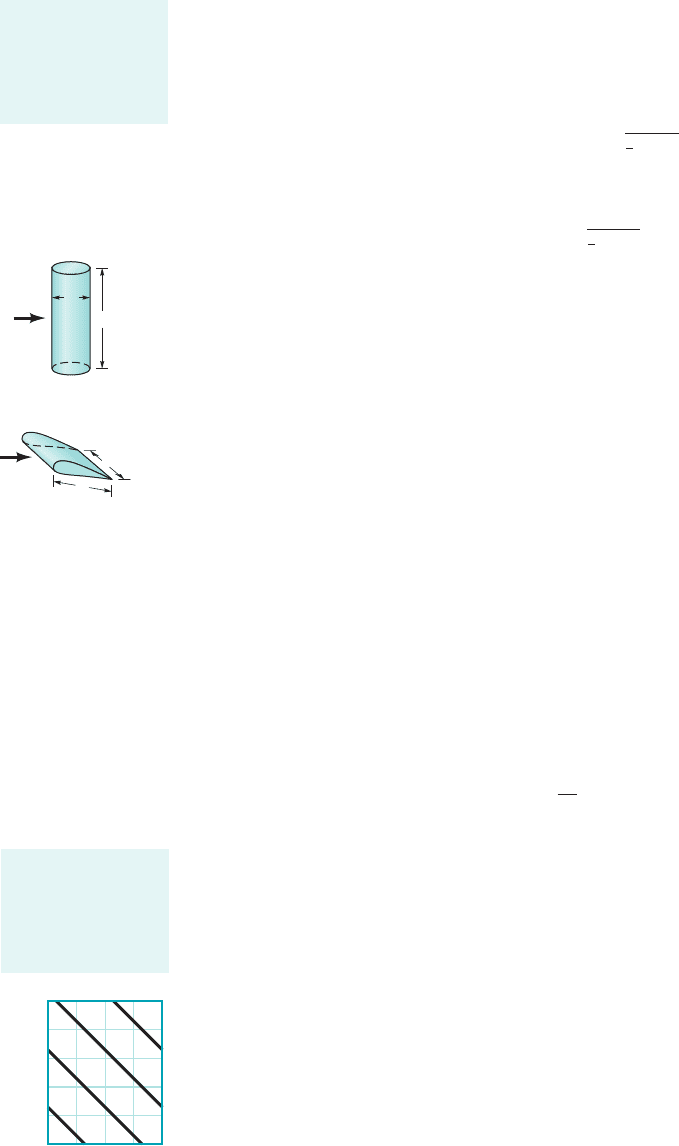
Although Eqs. 9.1 and 9.2 are valid for any body, the difficulty in their use lies in obtaining
the appropriate shear stress and pressure distributions on the body surface. Considerable effort has
gone into determining these quantities, but because of the various complexities involved, such infor-
mation is available only for certain simple situations.
Without detailed information concerning the shear stress and pressure distributions on a body,
Eqs. 9.1 and 9.2 cannot be used. The widely used alternative is to define dimensionless lift and
drag coefficients and determine their approximate values by means of either a simplified analysis,
some numerical technique, or an appropriate experiment. The lift coefficient, and drag coeffi-
cient, are defined as
and
where A is a characteristic area of the object 1see Chapter 72. Typically, A is taken to be frontal
area—the projected area seen by a person looking toward the object from a direction parallel to
the upstream velocity, U, as indicated by the figure in the margin. It would be the area of the shadow
of the object projected onto a screen normal to the upstream velocity as formed by a light shining
along the upstream flow. In other situations A is taken to be the planform area—the projected area
seen by an observer looking toward the object from a direction normal to the upstream velocity 1i.e.,
from “above” it2. Obviously, which characteristic area is used in the definition of the lift and drag
coefficients must be clearly stated.
9.1.2 Characteristics of Flow Past an Object
External flows past objects encompass an extremely wide variety of fluid mechanics phenomena.
Clearly the character of the flow field is a function of the shape of the body. Flows past relatively
simple geometric shapes 1i.e., a sphere or circular cylinder2are expected to have less complex flow
fields than flows past a complex shape such as an airplane or a tree. However, even the simplest-
shaped objects produce rather complex flows.
For a given-shaped object, the characteristics of the flow depend very strongly on various
parameters such as size, orientation, speed, and fluid properties. As is discussed in Chapter 7, ac-
cording to dimensional analysis arguments, the character of the flow should depend on the vari-
ous dimensionless parameters involved. For typical external flows the most important of these pa-
rameters are the Reynolds number, the Mach number, and for
flows with a free surface 1i.e., flows with an interface between two fluids, such as the flow past a
surface ship2, the Froude number, 1Recall that is some characteristic length of the
object and c is the speed of sound.2
For the present, we consider how the external flow and its associated lift and drag vary as a
function of Reynolds number. Recall that the Reynolds number represents the ratio of inertial ef-
fects to viscous effects. In the absence of all viscous effects the Reynolds number is in-
finite. On the other hand, in the absence of all inertial effects 1negligible mass or 2, the
Reynolds number is zero. Clearly, any actual flow will have a Reynolds number between 1but not
including2these two extremes. The nature of the flow past a body depends strongly on whether
or
Most external flows with which we are familiar are associated with moderately sized objects
with a characteristic length on the order of In addition, typical upstream ve-
locities are on the order of and the fluids involved are typically water
or air. The resulting Reynolds number range for such flows is approximately .
This is shown by the figure in the margin for air. As a rule of thumb, flows with are
dominated by inertial effects, whereas flows with are dominated by viscous effects. Hence,
most familiar external flows are dominated by inertia.
On the other hand, there are many external flows in which the Reynolds number is consid-
erably less than 1, indicating in some sense that viscous forces are more important than inertial
Re 6 1
Re 7 100
10 6 Re 6 10
9
0.01 m
s 6 U 6 100 m
s
0.01 m 6/610 m.
Re 1.Re 1
r 0
1m 02,
/Fr U
1g/.
Ma U
c,Re rU/
m U/
n,
C
D
d
1
2
rU
2
A
C
L
l
1
2
rU
2
A
C
D
,
C
L
,
466 Chapter 9 ■ Flow over Immersed Bodies
Lift coefficients and
drag coefficients
are dimensionless
forms of lift and
drag.
A = Dᐉ
A = cᐉ
ᐉ
ᐉ
U
U
c
D
The character of
flow past an object
is dependent on the
value of the
Reynolds number.
0.01
0.1
1
10
100
0.001
0.001
0.01 0.1 1 10
U, m/s
ᐉ, m
Re = 10
4
10
2
10
6
Air
1
JWCL068_ch09_461-533.qxd 9/23/08 11:47 AM Page 466
